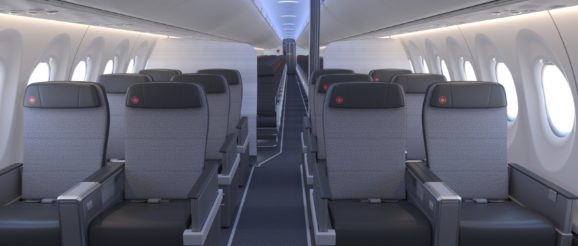Air Canada’s A220: Great, but waiting for cabin innovation

When Air Canada starts operating its Airbus A220 aircraft (né Bombardier C Series), it’s aiming long and thin within North America. Air Canada seems to be using the A220 as something of a “tech shuttle”: routes announced are from Montréal to Seattle and from Toronto to San José, the smaller airport to the south and east of Silicon Valley.
Both routes are likely to end up somewhere between five and a half and six hours long, and there’s a lot to be said for showcasing the passenger-pleasing attributes of the A220 on routes that are high value yet have relatively low demand.
These “long and thin” routes are one of the sweet spots Airbus has been banging on about for the A220, as indeed Bombardier was when the aircraft was previously called the C Series.
Mark Galardo, Vice President of Network Planning at Air Canada, explains that “the two routes announced today are the first of many future possibilities as the A220 will allow us to further develop our North American network, offering customers new routes and more robust year-round schedules.”
“Flights are timed to provide connectivity in Montreal to and from Europe and North Africa including Casablanca, Paris, Nice, Lyon, Algiers, London, Frankfurt, Geneva, Rome, Dublin and more,” the airline says, which rather usefully allows passengers the option of connecting at YUL to Europe and Africa rather than other airports. On the return, Canadian pre-clearance at Montréal is significantly more pleasant than waiting on arrival in the United States, where the flight will arrive as if it were a domestic service.
Inside the plane, the interiors are remarkably good. The 12 business class seats are Collins Aerospace MiQ, a hugely popular product in this sort of recliner segment (or if they’re not, they’re so close that someone’s going to be getting a call from some very unhappy lawyers). That’s the same seat that Delta Air Lines already operates on its A220s, although Air Canada’s appears to be in a fabric cover, which is substantially less sticky and thus more pleasant in warmer weather.
MiQ’s primary benefit, to my mind, is the retracting outside armrests, which are certainly there on the aisle side but which may not be there on the window side — it’s unclear at this point from the rendering image.
Still, apart from the important benefits of allowing wheelchair-using passengers to transfer easily across, the retracting armrests allow a wider range of seating positions and, helpfully, let the aisle side passenger swivel their knees around to let the window passenger out.
Back in economy, the wider seats of the A220 will make this an Air Canada aircraft of choice, and indeed will provide a more pleasant passenger experience than any Air Canada widebody, particularly its narrow 787 nine-abreast seating.
Full seatback inflight entertainment, as well as wifi and power are on board, with the juice supplied by AC sockets and both the larger USB-A and new smaller USB-C sockets. This is very smart on Air Canada’s part, and will be especially useful for these tech shuttles.
Air Canada’s A220 looks great and will undoubtedly be as popular as the others in service, if not more so thanks to all the bells and whistles. The wider implications for the A220, though, are certainly thought-provoking, especially in the pointy end.
This is only the second A220 with an actual premium cabin, with the aircraft at Swiss, airBaltic and Korean Air all-economy-seat variants with a bit of Eurobusiness middle-seat-free nonsense on the two European airlines. That Air Canada chose the same business seat as Delta would be more notable if it weren’t the popular MiQ, but even so it’s interesting to observe.
The A220 has a lot of potential, especially for long and thin routes like this. A big question remains whether any airline will add business class seating with more than a recliner on what is, in any case, the most comfortable narrowbody on the market.
The post Air Canada’s A220: Great, but waiting for cabin innovation appeared first on Airline Ratings.
